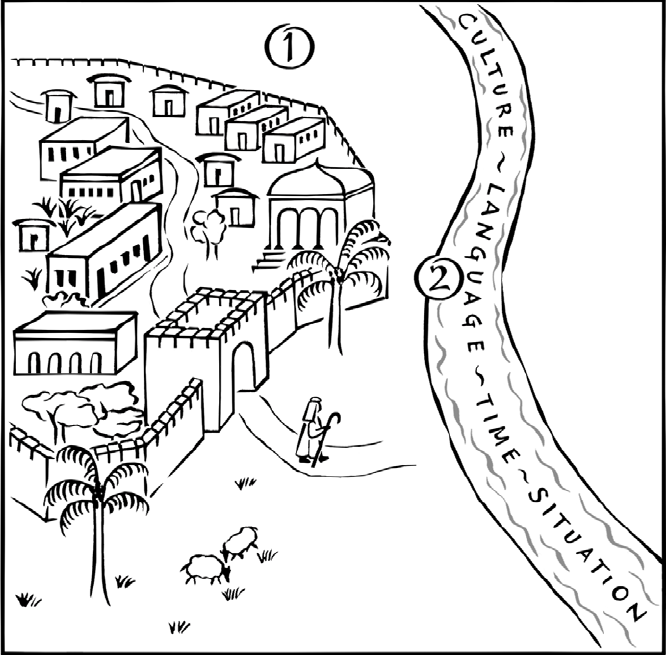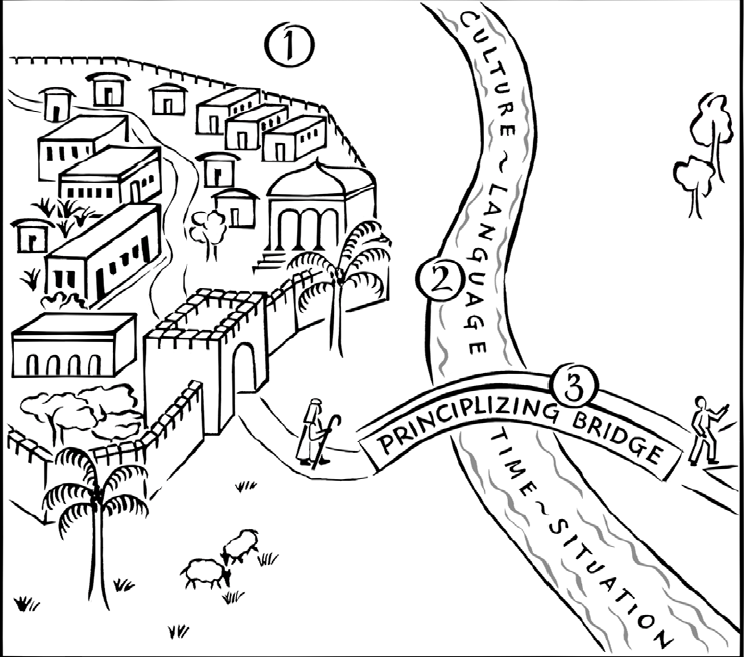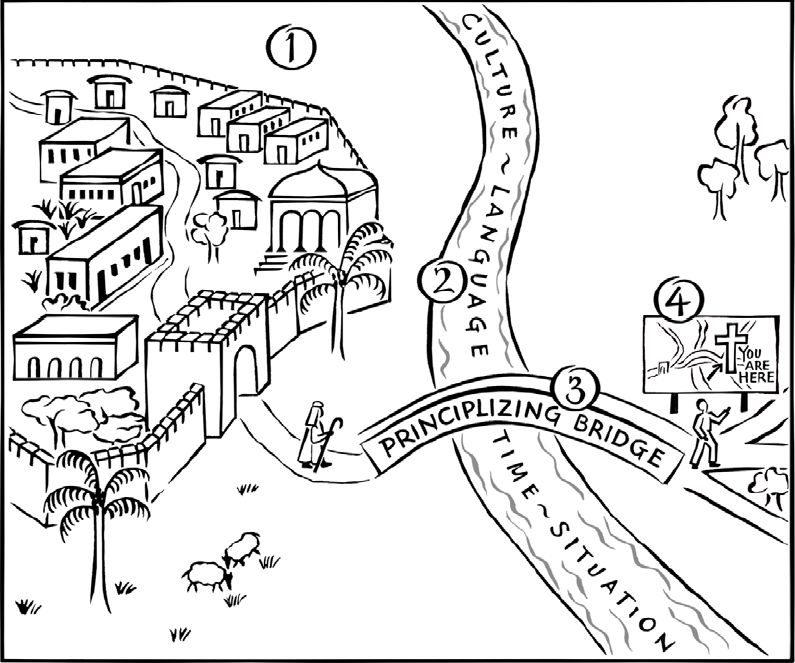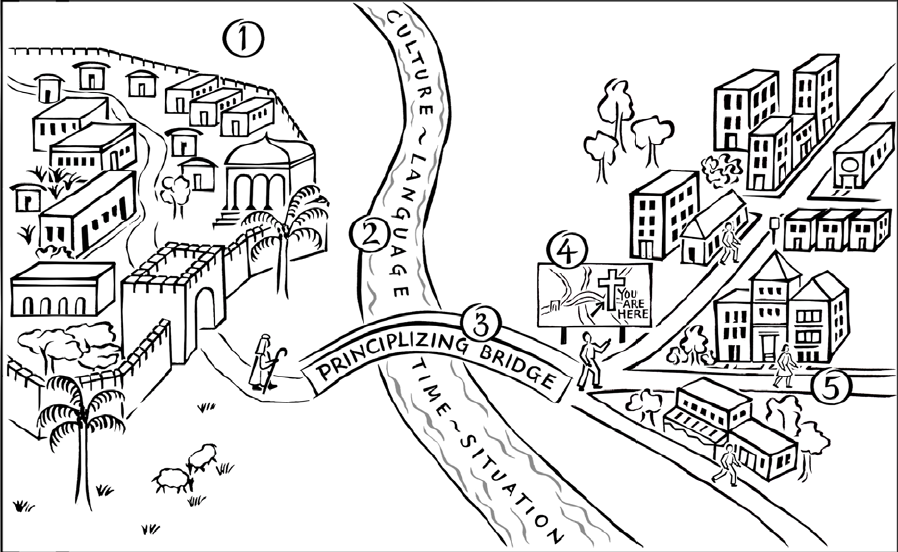Unit 2:1 Study Lesson
Basics of the Journey
Keep in mind that our goal is to grasp the meaning of the text God has intended. We do not create meaning out of a text; rather, we seek to find the meaning that is already there. However, we recognize that we cannot apply the meaning for the ancient audience directly to us today because of the river that separates us (culture, time, situation, covenant, etc.). Following the steps of the Interpretive Journey provides us with a procedure that allows us to take the meaning for the ancient audience and to cross over the river to determine a legitimate meaning for us today.
This journey works on the premise that the Bible is a record of God’s communication of himself and his will to us. We revere the Bible and treat it as holy because it is the Word of God and because God reveals himself to us through this Word. Many texts in the Bible are specific, concrete, revelatory expressions of broader, universal realities or theological principles. While the specifics of a particular passage may only apply to the particular situation of the biblical audience, the theological principles revealed in that text are applicable to all of God’s people at all times. The theological principle, therefore, has meaning and application both to the ancient biblical audience and to Christians today.
Because the theological principle has meaning and application to both audiences, it functions as a bridge spanning the river of differences. Rather than blindly wading out into the river, foolishly attempting to jump across the river in one short hop, or wishfully gazing at the other shore without ever crossing, we can safely cross over the river on the bridge that the theological principle provides. Constructing this principlizing bridge will be one of the critical steps in our Interpretive Journey.
Thus, our journey starts with a careful reading of the text. Our final destination is to grasp the meaning of the text so that it changes our lives. It is an exciting trip, but one that requires hard work. There are no easy shortcuts. The basic Interpretive Journey involves five steps:
Step 1: Grasping the Text in Their Town
Question: What did the text mean to the biblical audience?
The first part of Step 1 is to read the text carefully and observe it. In Step 1, try to see as much as possible in the text. Look, look, and look again, observing all that you can. Scrutinize the grammar and analyze all significant words. Likewise, study the historical and literary contexts. How does your passage relate to thosethat precede it and those that follow it?
After completing all of this study, synthesize the meaning of the passage for the biblical audience into one or two sentences. That is, write out what the passage meant for the biblical audience. Use past–tense verbs and refer to the biblical audience. For example:
God commanded the Israelites in Joshua 1 to . . .
Paul exhorted the Ephesians to . . .
Jesus encouraged his disciples by . . .
Be specific. Do not generalize or try to develop theological principles yet.
Step 2: Measuring the Width of the River to Cross
Question: What are the differences between the biblical audience and us?
As mentioned above, the Christian today is separated from the biblical audience by differences in culture, language, situation, time, and often covenant. These differences form a river that hinders us from moving straight from meaning in their context to meaning in ours. The width of the river, however, varies from passage to passage. Sometimes it is extremely wide, requiring a long, substantial bridge for crossing. Other times, however, it is a narrow creek that we can easily hop over. It is obviously important to know just how wide the river is before we start trying to construct a principlizing bridge across it.

In Step 2 you will take a good hard look at the river and determine just how wide it is for the passage you are studying. In this step you look for significant differences between our situation today and the situation of the biblical audience. If you are studying an Old Testament passage, also be sure to identify those significant theological differences that came as a result of the life and work of Jesus Christ.
In addition, whether in the Old Testament or in the New Testament, try to identify any unique aspects of the situation of your passage. For example, in Joshua 1:1–9, the people of Israel are preparing to enter the Promised Land. Moses has just died and Joshua has been appointed to take his place. In this passage God speaks to Joshua to encourage him to be strong and faithful in the upcoming conquest of the land. What are the differences? We are not entering or conquering the Promised Land. We are not the new leaders of the nation of Israel. We are not under the old covenant.
Step 3: Crossing the Principlizing Bridge
Question: What is the theological principle in this text?
This is perhaps the most challenging step. In it you are looking for the theological principle or principles that are reflected in the meaning of the text you identified in Step 1. Remember that this theological principle is part of the meaning. Your task is not to create the meaning but to discover the meaning intended by the author. As God gives specific expressions to specific biblical audiences, he is also giving universal theological teachings for all of his people through these same texts.

To determine the theological principle, first recall the differences you identified in Step 2. Next, try to identify any similarities between the situation of the biblical audience and our situation. For example, consider Joshua 1:1–9 again. Recall, of course, the differences that we identified in Step 2. But then note the similarities between the biblical situation and our own. We are also the people of God, in covenant relationship (new covenant); while we are not the leaders of Israel, nonetheless many of us are in leadership positions in the church; we are not invading the Promised Land, but we are seeking to obey the will of God and to accomplish what he has commanded us to do.
After reviewing the differences and identifying the similarities, return to the meaning for the biblical audience that you described in Step 1 and try to identify a broader theological principle reflected in the text, but also one that relates to the similarities between us and the biblical audience. In essence, the theological principle is the same as the “theological message” or the “main theological point” of the passage. We will use this theological principle as the principlizing bridge by which we can cross over the river of barriers.
We can summarize the criteria for formulating the theological principle with the following:
The principle should be reflected in the text.
The principle should be timeless and not tied to a specific situation.
The principle should not be culturally bound.
The principle should correspond to the teaching of the rest of Scripture.
The principle should be relevant to both the biblical and the contemporary audience.
Write out the theological principle (or principles) in one or two sentences. Use present–tense verbs.
Step 4: Consult the Biblical Map
Question: How does our theological principle fit with the rest of the Bible?
During this step you must enter the parts–whole spiral. That is, you reflect back and forth between the text and the teachings of the rest of Scripture. Is your principle consistent with the rest of Scripture? Do other portions of Scripture add insight or qualification to the principle? If your principle is valid, it ought to “fit” or “correlate” with the rest of the Bible.

If you are studying an Old Testament passage, consulting the biblical map (Step 4) is especially important, for here you will run your theological principle through the grid of the New Testament, looking for what the New Testament adds to that principle or how the New Testament modifies it. Keep in mind that we read and interpret the Old Testament as Christians. That is, although we believe that the Old Testament is part of God’s inspired Word to us, we do not want to ignore the cross and thus interpret and apply this literature as if we were Old Testament Hebrews. We affirm that we are New Testament Christians, and we will interpret the Old Testament from that vantage point.
Thus at the end of this step, sometimes you will need to reword your theological principle slightly to ensure that it fits with the rest of Scripture. Don’t ignore the elements you initially drew on in Step 3, but now fine–tune your principle if it needs it.
Step 5: Grasping the Text in Our Town
Question: How should individual Christians today live out the theological principles?
In Step 5 we apply the theological principle to the specific situation of individual Christians in the church today. We cannot leave the meaning of the text stranded in an abstract theological principle. We must now grapple with how we should respond to that principle in our town. How does it apply in real–life situations today?

While for each passage there will usually be only a few (and often only one) theological principles relevant for all Christians today, there will be numerous applicational possibilities. This is because Christians today find themselves in many different specific situations. Each of us will grasp and apply the same theological principle in slightly different ways, depending on our current life situation and where we are in our relationship with God. In our illustration, we have tried to show the different applications possible by showing different individuals traveling on different streets.
So, the Interpretive Journey as a whole looks like this:
Step 1: Grasp the text in their town. What did the text mean to the original audience?
Step 2: Measure the width of the river to cross. What are the differences between the biblical audience and us?
Step 3: Cross the principlizing bridge. What is the theological principle in this text?
Step 4: Consult the biblical map. How does our theological principle fit with the rest of the Bible?
Step 5: Grasp the text in our town. How should individual Christians today live out the theological principles?